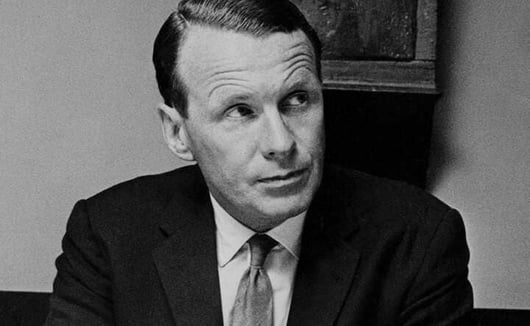
David Ogilvy: Five Lessons You Can Learn from “The Father of Advertising”
For marketers around the world, David Ogilvy remains a great source of knowledge and inspiration. Twenty years after his passing, “the father of advertising” continues to influence our thinking and practices, and helps us produce better work.
Today we want to talk about five of Ogilvy’s essential principles and see how we can use them to write better marketing copy. Copy that sells – for the very pragmatic David Ogilvy, this was the sole purpose of advertising.
Here’s what we can learn from David Ogilvy
Also, we’re going to break down one of Ogilvy’s most acclaimed ads — the one that doubled the sales for Rolls-Royce — and show you how to take his formula and apply it to your own copy.
Whether you write emails, social media ads and captions, or ebooks and other marketing resources, these tips will be invaluable.
1. David Ogilvy: The consumer is your wife.
“The consumer isn’t a moron. She is your wife. You insult her intelligence if you assume that a mere slogan and a few vapid adjectives will persuade her to buy anything. She wants all the information you can give her.”
We started with this not because it’s David Ogilvy’s most well-known quote. But rather, because it sums up what great copy should sound like.
Many times, companies tend to forget that their audiences aren’t abstract entities, but real people. And real people need a good reason to:
- read your copy in the first place
- and respond to your call-to-action.
David Ogilvy always kept this in mind when writing his ads, and instead of using praising adjectives, he focused on practical information and benefits.
“Show, don’t tell” was his advertising mantra.
To illustrate, here is one of the most successful ads David Ogilvy ever wrote.

It first ran in 1958 and was introducing the Rolls-Royce Silver Cloud.
“Before I wrote this — the most famous of all automobile ads — I did my homework,” Ogilvy said. “It ran only in two newspapers and two magazines, at a cost of $25,000. The following year, Ford based their multi-million dollar campaign on the claim that their car was even quieter than a Rolls.”
So, what is it about this ad that made it so successful?
I read the entire copy again, trying to spot any complimentary adjectives. There are only three — safe, lively and rewarding — but far into the ad, in section 12 and in the call-to-action.
Ogilvy starts with a benefit-focused headline that shows the reader how silent the car’s engine was.
In fact, this is one of the best examples of how the “show, don’t tell” approach works in copywriting.
Let’s do a quick exercise so you can see what a difference it makes to show your reader a benefit instead of simply stating it.
Telling: “This new Rolls-Royce has a very silent engine.”
Showing: “At 60 miles an hour the loudest noise in this new Rolls-Royce comes from the electric clock.”
See how David Ogilvy’s version helps you feel how silent this car is?
By simply reading the copy, you can picture yourself behind the wheel, driving smoothly on the highway on a serene summer day. Because the engine is so quiet, you can roll down the windows and hear the birds chirping.
This is storytelling at its best. If you can make your reader dream like this, you’ve got powerful copy!

Now, take another look at the ad and notice its structure.
Right after the headline, David Ogilvy added a subheadline:
“What makes Rolls-Royce the best car in the world?”
In journalism, this piece of copy that goes right under your headline is called a “subheading,” a “subtitle” or a “dek” (also spelled “deck” at times).
Because no one writes for people better than journalists do, marketers have assimilated this tactic and incorporated it into their own writing.
Tip: Think of your subheading as a hook
It should grab the reader’s attention and show her why your copy is worth reading. For best results, try to avoid repeating what you’ve already said in the headline. Rather, elaborate on that initial statement and even introduce a new idea. Then, use the deck to take your reader by the hand and guide her towards your story.
In an email, your subheading is your very first sentence (or phrase). Next time you write it, ask yourself: what would a journalist say?
Can’t figure it out? Stay tuned, more tips on this later.

Note: The subheading is the only place where David Ogilvy makes a bold statement by saying the new Rolls-Royce is the best car in the world. But then he goes on to say:
“There is really no magic about it — it is merely patient attention to detail.”
The entire rest of the ad focuses on these details and speaks about the practical features of the car and how they translate in “a rewarding driving experience.”
This is the third praising adjective Ogilvy uses — but only after he explained why driving this Rolls is rewarding.

To sum up the formula David Ogilvy used in this Rolls-Royce ad:
- do as much research as possible. You have to know your product very well before you can begin to sell it.
- show, don’t tell — and start doing that right in the headline.
- next, write a hook to give your reader more reason to pay attention and continue to read your copy.
- provide specific information about your service or product.
- when describing your offer, limit the use of praising adjectives.
- end with a simple and clear call-to-action.
2. Creativity that doesn’t sell is useless
“When I write an advertisement, I don’t want you to tell me that you find it creative. I want you to find it so interesting that you buy the product.
(…) Your role is to sell, don’t let anything distract you from the sole purpose of advertising. In the modern world of business, it is useless to be a creative, original thinker unless you can also sell what you create.”
This may seem quite dismissive, but David Ogilvy never lost sight of his goal. His copy aimed to persuade people and turn them into customers.
While he was an avid researcher and a person with a strong sense of imagination, Ogilvy didn’t value creativity for the sake of creativity. He measured it in the results it provided.
So, when writing your emails, allow your creativity to play. However, keep your eye on the prize and stay focused on what you’re trying to accomplish.
Bonus tip: to make sure your email reaches your subscribers, use an email list cleaning system to validate your database.

3. That crazy idea you had — it could be your next email. Or business!
“The best ideas come as jokes. Make your thinking as funny as possible.”
It happens to all of us: we sit down and talk to a friend or colleague, and one of us makes a joke. A minute later, we start to wonder whether we could find a way to turn it into something real.
Some of our ideas may seem too crazy to implement. Others may turn out to be goldmines, so don’t be afraid to pursue them. Some legitimate, high-profit businesses started as jokes!
What if you could take that conversation you had with your friend and use it in your next email? Or turn it into a social media post?
“Big ideas, that’s what the advertising business is all about.”
When talking about how big ideas happen in advertising, David Ogilvy outlined these essential steps:
Study the product.
My advice is to start by doing your homework. The more you know about the product, the more likely you are to come up with a big idea for selling it. Study the precedents. Look up the campaigns for similar products in recent years. Find out which worked and which didn’t work, and then go on better. Study the research – how consumers think about your kind of product, what benefit you should promise them.
Boil down your strategy to one single promise.
.. and go the whole hog in delivering that promise. The promise should be important and unique. And use research to find out what promise is most persuasive. Look before you leap.
Don’t be a bore.
You cannot bore people intro buying your product, you can only interest them in buying it.
The beginning of greatness, in advertising, is to be different.
… and the beginning of failure is to be orthodox. So be ambitious, raise your sights, blaze new trails, try to make advertising history.

4. Experiment until you find your winning strategy
“Never stop testing, and your advertising will never stop improving.”
You can easily apply this advice to your advertising, as well as your email marketing strategy. The world is constantly changing, and so are your audience’s expectations. So it makes sense to update your techniques to stay on top of your game.
You can start today by trying a different approach in your email marketing:
- experiment with different types of content, subject lines and calls-to-action.
- then look at your reports and see what performs best.
- lastly, pay attention to the details and fine-tune your strategy.
“Perhaps the single most important word in the lexicon of advertising is test,” David Ogilvy said. So, “always keep testing. Testing new ideas, new headlines, new levels of spending, new media combinations, new kinds of commercials. Test, test, test.”

5. Do your research, then let your mind wander
“Big ideas come from the unconscious. This is true in art, in science, and in advertising. But your unconscious has to be well informed, or your idea will be irrelevant.
Stuff your conscious mind with information, then unhook your rational thought process. You can help this process by going for a long walk, or taking a hot bath, or drinking half a pint of claret. Suddenly, if the telephone line from your unconscious is open, a big idea wells up within you.”
Have you watched “Mad Men”? Then you may remember that scene where Peggy feels stuck and unable to come up with an idea for a campaign.
Don Draper’s advice:
“Think about it really hard. Learn everything. Then, forget about all of it and an idea will just pop into your mind.”
The writers of “Mad Men” may have gotten this tactic from David Ogilvy and made the most of it in their script. But did you know Ogilvy actually learned it from James Webb Young, whom he considered, at the time, the best copywriter alive?
Without research, it’s almost impossible to create great content — whether for ads, email marketing or social media. So, when working on a new piece of copy, keep gathering information until you feel prepared for your next step.
But to avoid feeling overwhelmed, alternate research with breaks — long, restful breaks. Take a step back to clear your mind. Let all that information germinate and allow it to grow into your next idea.
Going back to “Mad Men,” what did Don do before he came up with his greatest ad ever? He took a long, long break. Here’s what happened after (spoiler alert):
Bonus tip: Think like a journalist
“Editors of magazines are better communicators than advertising people. Copy their techniques.”
David Ogilvy
Remember we talked about subheadings earlier? Adding them under headlines is just one technique journalists use in their articles. If you look at some of the best copy around, you’ll notice many other practices that marketers borrowed from journalists and use successfully.
So, if you want to improve your copywriting, take some time every week to read the press.
Of course, you can go online and take a look at some of your favorite newspapers and magazine. However, make sure to buy a paper, too, once in a while. The layout of the copy in print is different and you’ll see more clearly how to structure your next article, ad, or email.
In his great book “The New Rules of Marketing and PR,” marketing strategist David Meerman Scott has a whole chapter on this topic. His advice if you want to be a better marketer? Think like a publisher.

Must-read: David Ogilvy’s books on advertising
Founder of Ogilvy and Mather, David Ogilvy created some of the most iconic advertising campaigns. He worked for Schweppes, Rolls Royce, Shell, Dove, and the island of Puerto Rico.
In 1962, Time magazine called him “the most sought-after wizard in today’s advertising industry.”
Want to learn more from David Ogilvy? Read his books:
- “Confessions of an Advertising Man” — he wrote it in 1963, and his advice has remained current to this day. You’ll learn so much!
- “Ogilvy on Advertising” – published in 1983, it covers the secrets behind great ads.
This article was published in February 2018 and updated in October 2019.






